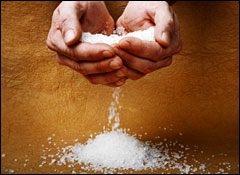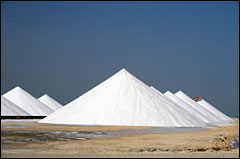Dear Umbra,
What’s up with salt, environmentally speaking? Is it good for the Dead Sea if I buy Dead Sea salt (but then it travels halfway around the world)? Am I getting trace amounts of Bad Stuff in any sea salt these days? Is a big box of Morton iodized salt going to overload the bath-soaker with iodine? And how much of my bath salt is going to mess with the Great Lakes — not nearly as much as the salted winter roads, I suspect.
Mo Ram
Lakeside, Ohio
Dearest Mo,
A shaker full of salty questions. As you know, eating a modest amount of salt is an important part of staying alive. Therefore one cannot be environmentally chaste about one’s dietary use of salt. The main use of salt today, however, seems to be in chemical and manufacturing processes (such as making chlorine), so as we reduce our general overconsumption of Things, we will reduce our participation in any ecological problems with salt harvest and disposal.

A grain in the hand …
Photo: iStockphoto
That said, you can stop purchasing salt from the Dead Sea.
All salt comes from contemporary or historical seas. The historical seas have left salt veins lying beneath the ground. The dry salt we use in food (and on roads) is mined or evaporated. Salt mines are room and pillar mines; the miners carefully remove the rock by blasting or boring, and calculate exactly where they need to leave salt pillars to hold up the ceiling of the mine. Rock salt for roads comes from room and pillar mining. Underground salt can also be captured by shoving water into the ground in order to dissolve the salt, then evaporating off the salt from the resultant brine.
Current oceans are mined for their salt in a different way, of course. In hot areas where evaporation exceeds precipitation, salt is harvested from water using a series of evaporative ponds. In one French salt-producing area, the mound of drying salt grows to be 2,460 feet long, with a million metric tons of salt. Apparently all salt used at table in the U.S. (much of it made here) is from vacuum pan evaporation, which is too technical for me to bother explaining other than to say it replicates solar evaporation inside a container.

… is worth a million metric tons in the heap.
Photo: iStockphoto
So what is up with salt, environmentally speaking? Well, salt extraction can have an impact on saline watersheds, which is in part what has happened to the shrinking Dead Sea. I’m sure your gourmet (or spa, whichever) Dead Sea salt is only a small contributor to the problem, with chemical industries making up the bulk of the issue. However, since you bothered to ask, you might as well bother to give up thinking that Dead Sea salt is any different or better than domestically produced non-gourmet salt. Chemically, they are the same salt.
As for road salt vs. bath salts — jeepers, you would need to use a lot of bath salts to even approach the groundwater pollution and vegetation impacts of salt-based de-icing chemicals. Long before your bath salts became rock-salt comparable, your water usage would be off the charts, and that would be the larger concern during a home environmental audit. I’m out of space, and it’s about health, so I beg off the iodine question.
Jobly,
Umbra
